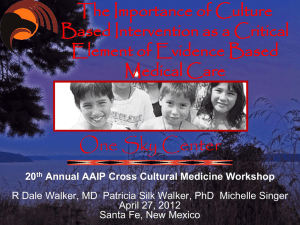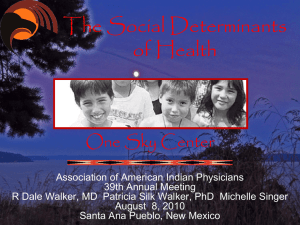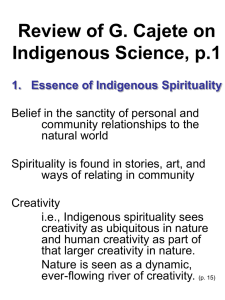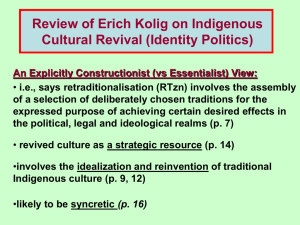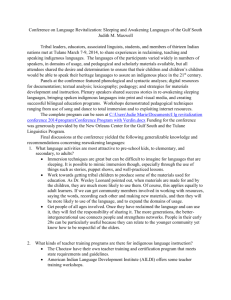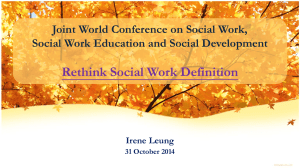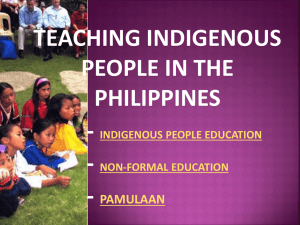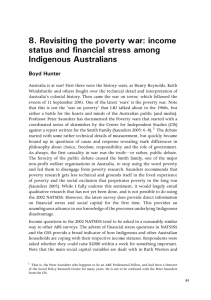Taking Care of Home: Evidence-Informed Culture
advertisement
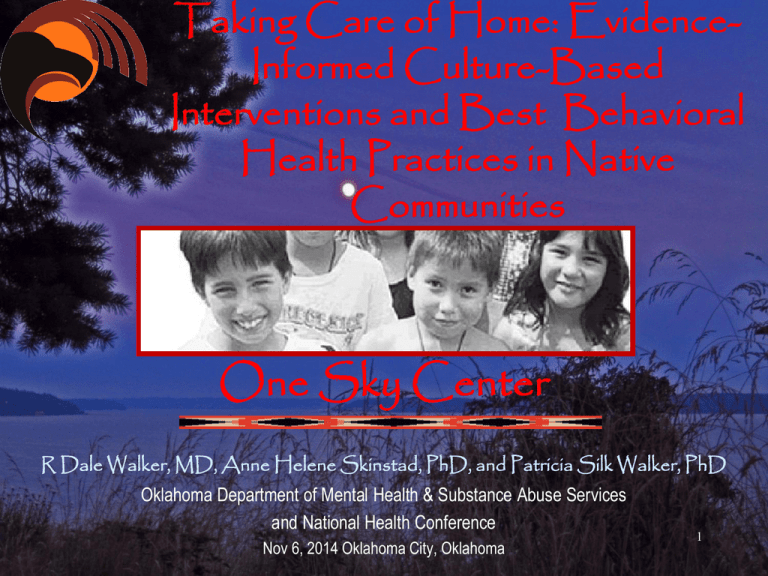
Taking Care of Home: EvidenceInformed Culture-Based Interventions and Best Behavioral Health Practices in Native Communities One Sky Center R Dale Walker, MD, Anne Helene Skinstad, PhD, and Patricia Silk Walker, PhD Oklahoma Department of Mental Health & Substance Abuse Services and National Health Conference Nov 6, 2014 Oklahoma City, Oklahoma 1 Education, Mentorship, Retention Opportunity, Research, Recruit One Sky Center Training, Consultation, Technical Assistance Excellence Tribal Leadership 2 Definition: Indigenous Knowledge • Local knowledge unique to a given culture or society; it has its own theory, philosophy, scientific and logical validity, used as a basis for decision-making for all of life’s needs. 3 4 Definitions: Traditional Medicine • The sum total of health knowledge, skills and practices based upon theories, beliefs and experiences indigenous to different cultures…used in the maintenance of health. WHO 2002 5 Goals for Today • • • • • • • Review Native Health Circumstances Explain Culture Based Interventions Explore Social Determinants of Health Discuss Human Development Index A Little Surprise Review Native Mentorship Opportunities Advocacy –Getting the Job Done 6 WHO ARE INDIGENOUS PEOPLES? “Indigenous peoples remain on the margins of society: they are poorer, less educated, die at a younger age, are much more likely to commit suicide, and are generally in worse health than the rest of the population." (Source: The Indigenous World 2006, International Working Group on Indigenous Affairs (IWGIA) WHO 7 INDIGENOUS PEOPLE WORLD MAP - 370 million indigenous peoples living in more than 70 countries 8 • Geography: Where we live, how we live • Identity: How we define who we are • Stereotypes: How we have been defined by others through the years • Disparity, Morbidity, Mortality 9 Early Human Migrations 1st Migration, 38,000-1800 BCE 2nd Migration, c. 10,000-4,000 BCE 3rd Migration, c. 8,000-3,000 BCE 1491 American Indian/Alaskan Native As a Percentage of the total population GEOGRAPHY: Population Growth and Resettlement Means that in Addition to the Federal Government, We Now Must Work With States, Counties, and Cities to get Our Health and Education Needs Met 12 13 14 Projective Negative Stereotyping 15 Native Healthcare Appropriations Compared to Other Federal Health Expenditures, 2006 16 17 Native Health Morbidity: Disparity 1. 2. 3. 4. 5. 6. 7. 8. Alcoholism 6X Tuberculosis 6X Diabetes 3.5 X Accidents 3X Poverty 3x Depression 3x Suicide 2x Violence? 1. Same disorders as general population 2. Greater prevalence 3. Greater severity 4. Much less access to Tx 5. Cultural relevance more challenging 6. Social context disintegrated 18 American Indian/Alaska Native Admissions, by Gender, Primary Substance, and Age: 2009 19 Mortality Rates: Disparity AI/AN ALL • • • • • • • • • ALL CAUSES 953.7 Alcohol induced 45.0 Diabetes 65.6 Homicide (assault) 11.0 Infant Deaths 7.3 Maternal Deaths 20.2 Pneumonia/Influenza 24.3 Suicide 19.0 Uninten. Injuries* 94.8 776.5 6.9 23.3 6.0 6.7 13.3 17.8 10.9 39.8 Ratio 1.2 6.5 2.8 1.8 1.1 1.5 1.4 1.7 2.4 20 Death Rates Attributed to Alcoholic Liver Disease 21 Major AI/AN Health Disparities • • • • • • • Chronic Diseases Infant Mortality Sexually Transmitted Diseases (STDs) Injuries Obesity Mental Health Substance Abuse Source: OMHD CDC http://www.cdc.gov/omhd/Brochures/PDFs/1PAIAN.pdf 22 Rates of Suicide by Race 2010 17.3 16 5.3 5.3 6.3 23 Suicide Among ages 15-17, 2001 Death rate per 100,000 16 14 12 10 8 6 4 2010 Target 2 00 Total Females Males Source: National Vital Statistics System - Mortality, NCHS, CDC. 24 Prescribing Psychotropic Meds Mark T, et al. Psych Mark T, et al. Psychotropic drug prescriptions by medical specialty. Psychiatric Services (2009). Vol 60. No 9. p. 1167 Survey…. • Have you ever directly asked someone if he/she was thinking about ending his/her life? – Yes – No 26 Causes of Health Disparities 1. Limited Access • IHS Eligibility • Direct/Tribal/Urban • Direct Delivery • Tribal Health • Urban Indian Health • Contract Health Services Program 2. Poor Access to Health Insurance • Social and Cultural Factors • Procedural Factors • Collection Factors 3. Insufficient Federal Funding 4. Quality of Care Issues • Ability to Recruit and Retain Health Providers • Accreditation Status • Importance of .Culturally Competent. Health Services • Problem of Aging Facilities 5. Disproportionate Poverty and Poor Education 27 Social Determinates of Health: Whitehall Studies • Within a hierarchical society, there is a social gradient for morbidity and mortality. (Poverty, sanitation, nutrition, and shelter are controlled.) • Higher status folks live longer and healthier. Health Care Improvement Needs More Than Money: • Opportunity, Empowerment, Security, Control, and Dignity…. www.thelancet.com Dec 9, 2006. Marmot Amartya Sen 1998 Nicholas Stern 2004 28 . Socio-cultural Socioeconomic Biological Science & Technology Aging Health Behavioral Education Gender Environmental Human Rights Social Justice 29 Role of Inequities in Healthcare Simulation :Estimated % Contribution to Health Disparity other 5% genes 3% poverty 25% racism 15% Adapted from V. Hogan health care 10% behaviors 20% culture 10% environment 15% 30 Childhood Mortality Versus Wealth 31 Poverty Rate Percentage of Persons in Poverty: Race U.S. Census 2006 SAT Scores by Income Family Income Median Score More than $100,000 $80,000 to $100,000 1129 1085 $70,000 to $80,000 $60,000 to $70,000 $50,000 to $60,000 $40,000 to $50,000 $30,000 to $40,000 1064 1049 1034 1016 992 $20,000 to $30,000 $10,000 to $20,000 Less than $10,000 964 920 873 Source: (ETS) Mantsios; N=898,596 DETERMINANTS OF HEALTH: RACE AND ETHNICITY • • • • • • • Economic Political Social Educational Employment Income Access to health care • Environment • Law Enforcement / Justice • Home • Colonialism as a Broader Social Determinant of Health 34 Fair Society: Healthy Lives: Six Policy Objectives A. Give every child the best start in life B. Enable all children, young people and adults to maximize their capabilities and have control over their lives C. Create fair employment and good work for all D. Ensure healthy standard of living for all E. Create and develop healthy and sustainable places and communities F. Strengthen the role and impact of ill health prevention Human Development Index NOTICE: The 2014 Human Development Report 'Sustaining Human Progress: Reducing Vulnerabilities and Enhancing Resilience' will be launched on 24 July in Tokyo at 2 PM Tokyo (GMT + 9) 36 Measures of Well Being by Race 37 Selected International Human Development Index Scores: 2001 • • • • • • • • 1 Norway .944 2 Iceland .942 3 Sweden .941 4 Australia .939 5 Netherlands .938 6 Belgium .937 7 United States .937 8 Canada .937 • • • • 20 New Zealand .917 23 Portugal .896 30 South Korea .879 31 U.S. American Indian and Alaska Native .877 • 32 Czech Republic .861 • 33 Canadian Aboriginal 38 39 What are some promising strategies? 40 Practice (Service) Best Practice Culture Values Philosophies Belief about causes of problems and solutions Local innovation, trial and error Medicinal use of wild plants and minerals Healing procedures Oral transmission of knowledge Community evaluation and acceptance Science & Scholarship 4/13/2015 Using the OPRE Review 41 Community Based Logic Model 1. Causes 8. Long term (Impact) Goals 7. Medium term 2. 6. Short term Outcomes Target Population 5. Operations Manual 4. Theory of Change 3. Strategy 4/13/2015 Intervention Using the OPRE Review 42 Key Activities in a Technology Needs Assessment Community input, tribal history early and recent. Their theory of cause and solutions. Not there to stop problem but help them. Establish Cultural Alignment. Work in partnership with community towards assessment. Build team across community systems; School, Legal, Health. Identify best fit of technology with community. “Indianize” or use a traditional approach Deliver continued contact with involvement of community leaders. Ceremony as a part of success. Build the story Continuously develop outreach and build knowledge. Tribe begins to own new theories of causes and solutions. Disseminate to other tribes and communities. Center of opportunity becomes a center of excellence. Hay, 2003 Walker, 2013 43 The Wharerātā Declaration 1. Indigeneity 2. Best / Wise Practice 3. Best / Wise Evidence 4. Indigenous Leadership a. Informed d. Connected b. Creditable e. Sustainable c. Strategic 5. Indigenous Leadership Influence 44 Six Key Principles Evidence-based Predictors of Change • • • • • • Leadership Mobilization Community driven Public health approach Strength based Culturally informed Proactive 45 Let’s Make a Difference! 46 Contact us at 503-970-7895 E-mail Dale Walker, MD walkerrd@ohsu.edu Or visit our website: www.oneskycenter.org 20 47 48
